
Subject: IC 1318 Nebula in Cygnus
Date: 2014-09-03
Location: WV
Equipment: WO FLT-110, 0.8x reducer/flattener, f/5.6, STF-8300M, SG-4
Exposure: Hα 105 min
Notes: Center region of Cygnus near the star Sadr. Cooled CCD camera with
7 nm Hα filter. Compare this image with the image below taken with a
DSLR. Using an interference filter lets you focus the optics for a specific
wavelength. This gives much sharper images. The dark areas are fine clouds
of dust floating in front of the enormous cloud of hydrogen gas, which
emits deep red light.
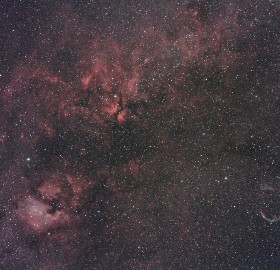
Subject: Cygnus nebulae and Veil Nebula
Date: 2013-09-23
Location: WV
Equipment: Modified Nikon D90, Nikkor 50mm f/1.2 at f/2.0, Hα and OIII filters
Exposure: 72.4 min Hα, 20.0 min OIII, ISO 400
Notes:
This false-color composite widefield image shows part of the Milky Way and the nebulas
around the star Sadr (Gamma Cygni), which is the center of the “cross”
in Cygnus. The butterfly-shaped IC 1318 nebula
in the center and the tiny C-shaped Crescent Nebula (NGC 6888) above and to its right
appear red. The large white nebula at the lower left is the North America Nebula (NGC 7000).
Just above it is the Pelican Nebula. The white parentheses-shaped one at lower right
is the Veil Nebula (IC 1340). Red = H-alpha, Green and blue = OIII. No telescope was
used, only a f/1.2 camera lens.
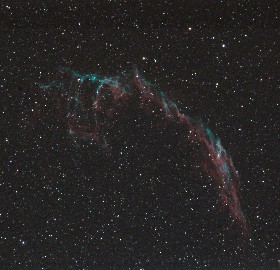
Subject: Veil Nebula (Eastern half)
Date: 2013-10-01
Location: WV
Equipment: WO FLT-110, 0.8x reducer/flattener, f/5.6, Modified Nikon D90, SG-4
Exposure: No filter ISO 200, 54 min + Hα ISO 800, 80 min + OIII ISO 800, 60 min
Notes: Combined image from filtered and unfiltered images. Compare this image with
the image below taken without filters. It's still more grainy than I would like.
From this location, getting a better image would mean combining multiple days or
buying a more sensitive camera.
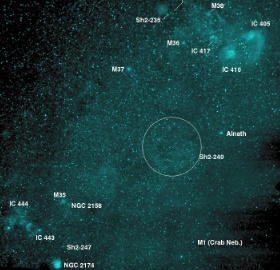
Subject: Sh2-240 in Taurus
Date: 2014-01-29
Location: WV
Equipment: Nikkor 50 mm f/1.2 lens at f/2, Modified Nikon D90, ISO 1600, CGEM
Exposure: 96 min (Hα) + 7.6 sec visible
Conditions: Trans.4/5, Temp.−3°F (−19°C)
Notes: Widefield image taken without a telescope.
Sh2-240 (Simeis 147) is a supernova remnant about 3000 light years away.
It is one of the faintest objects in the sky, but also one of the most beautiful.
Its appearance is of fine filaments in a circular
pattern much larger in apparent size than the moon. A large number of other
objects (Messier 1, 35, 36, 37, and 38) as well as IC 410 (the Tadpole Nebula),
NGC 2174 (Monkey Head Nebula), and IC 443 (Jellyfish Nebula) are also visible.
At this scale, M1 (Crab Nebula) is just a large blue dot.
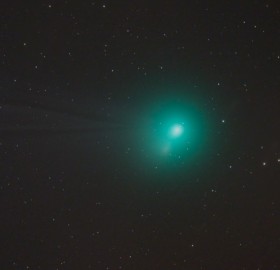
Subject: Comet Lovejoy
Date: 2015-01-15, 9:45 to 10:35 pm
Location: WV
Equipment: WO FLT-110, 0.8x reducer/flattener, f/5.6, Nikon D7000, SG-4
Exposure: Total of 45 min
Conditions: Trans.3/5, Seeing 1/5 Temp. 29°F
The comet was just west of Pleiades.
The blue-green color comes from cyanogen (a dimer of cyanide, NC-CN) and diatomic carbon
(C=C), known as Swan bands. Reflected light also contributes to the blue color, especially
in the tail. Photographing a comet is tricky because they move very fast against the star
background, so images taken more than a few minutes apart have to be processed by computer
to avoid blurring. In this image, the mount stopped working, my timer snapped off, and
the ground was a freezing bog of melting snow.

Subject: Comet Lovejoy
Date: 2015-01-16, 7:50 to 9:50 pm
Location: WV
Equipment: f/2.8 180 mm lens set to f/3.2, SG-4
Exposure: Total of 120 min
Conditions: Trans.3/5, Seeing 2/5 Temp. 31°F, some clouds
Different view of Comet Lovejoy (C/2014 Q2)
taken with a camera lens and processed to show the tail. The tail has a faint bluish
color which is partly caused by fluorescence of carbon monoxide (CO+) ions caused
by UV radiation from the Sun. In binoculars the comet appears as a fuzzy gray ball.
The nucleus is only about 2-3 miles across, but the visible head is about 400,000
miles in diameter—about half the diameter of the Sun. The comet is moving
toward the upper right, in the direction of the streaks, but the tail always points
away from the Sun.
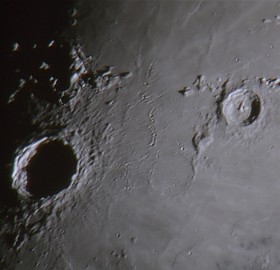
Subject: Moon craters Copernicus and Eratosthenes
Date: 2012-11-22
Location: WV
Equipment: C8HD, 14mm eyepiece, D7000
Exposure: MOV, 243/606 frames
Notes: Copernicus, on the left, is a young crater (800 MY) about 93 km in diameter.
The smaller crater Gay-Lussac directly above it is mostly in shadow. The crater in
the center is Eratosthenes. To its right is the Montes Apenninus, named after the
Apennine Mountains in Italy. The remnants of an ancient crater called Stadius are
discernable between these two prominent craters. The flat gray area above Eratosthenes
is the Mare Imbrium, an enormous lava flow.

Subject: Moon in late afternoon
Date: 2012-11-18, 5:56pm
Location: WV
Equipment: WO FL-110, f/5.6, D7000
Exposure: 1/120sec, ISO 100
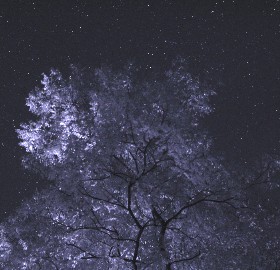
Subject: Infrared photo of trees and stars
Date: 2013-09-27, 9:26pm
Location: WV
Equipment: Modified D90, Nikkor f/1.2 50mm, f/2, CGEM, XNite BPG (796-877 nm pass filter)
Exposure: 12.6sec, ISO 1600
Notes: Facing west. The tree is partially illuminated from behind by car
headlights. A short exposure was necessary because the stars and the tree
are moving relative to each other. The longer infrared wavelengths from the
BPG filter appear in both red and blue channels, so the sky appears dark blue.
The bright star at the center right is Grumium in the constellation Draco.
Many more stars are visible in the infrared than in the visible.
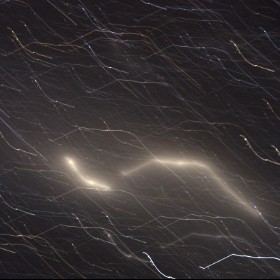
Subject: Guider crash in Andromeda
Date: 2012-11-10
Location: WV
Equipment: WO FLT-110, 0.8x reducer/flattener, f/5.6, Modified Nikon D90, SG-4
Exposure: ISO 1600, exposure 10 min
Notes: Another guider crash. The large fuzzy streak in the center-right is the
galaxy of Andromeda.
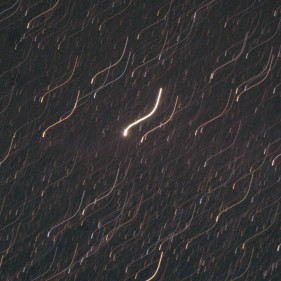
Subject: Guider crash in Cygnus
Date: 2012-09-17
Location: WV
Equipment: WO FLT-110, 0.8x reducer/flattener, f/5.6, Modified Nikon D90, SG-4
Exposure: ISO 1600, exposure 2 min
Notes: This is what happens when you don't pay attention after setting up.
The guider was too close to the tripod and eventually crashed into it. Luckily
I came back outside right as it happened. The images of the Veil Nebula were
not good enough to use, but this one was interesting.
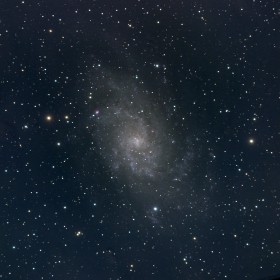
Subject: Messier 33 (M33) Galaxy in Triangulum
Date: 2012-11-17 and 2011-10-08
Location: WV
Equipment: WO FLT-110, 0.8x reducer/flattener, f/5.6, modified Nikon D90, CGEM, SG4
Exposure: ISO 400, 262 min total exposure
Conditions: Humidity 70%, Transparency 4/5, Seeing 3/5, Temperature 32°F, lim mag 6.1
Notes: This galaxy is tough to see even on those rare occasions when the sky is dark,
but it shows up easily in the camera. The small fuzzy pink blobs are nebulas in the M33
galaxy, over 3 million light years away. Although they appear small, some of these
nebulae are much larger than any of the nebulas in our galaxy. Yes, it looks pretty
nice over there.
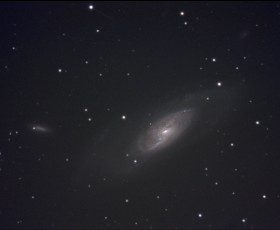
Subject: Messier 106 galaxy (NGC 4528) and NGC 4248 in Canes Venatici
Date: 2012-02-26
Location: WV
Equipment: C8HD, f/10, modified Nikon D90, CGEM, no guiding
Exposure: ISO 1600, total exposure 166 min
Conditions: Clouds 0%, Transparency 4/5, Seeing 3/5, Limiting mag 6.0,
Humidity 60%, Temperature 30°F
Notes: NGC 4248 is the smaller galaxy at left. M106 is supposed to be
easy to photograph, but it is a bear to make the faint outer arms visible
without introducing graininess. Small pink nebulas are visible in the
edges of the central region. Some people enhance the color to make the
outer arms appear blue.
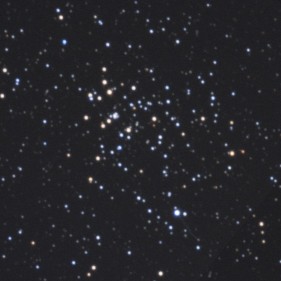
Subject: NGC 2360 in Canis Major
Date: 2012-02-26
Location: WV
Equipment: C8HD, f/10, modified Nikon D90, CGEM, no guiding
Exposure: ISO 1600, total exposure 28 min
Conditions: Clouds 0%, Transparency 4/5, Seeing 3/5, Limiting mag 6.0,
Humidity 60%, Temperature 30°F
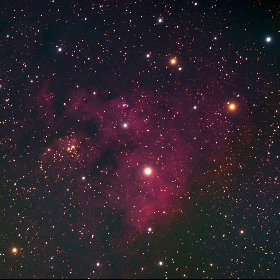
Subject: Ced 214 Nebula in Cepheus
Date: 2011-10-16
Location: WV
Equipment: WO FLT-110, 0.8x reducer/flattener, f/5.6, modified Nikon D90, CGEM, no guiding
Exposure: ISO 1600, 133x60 sec, DSS
Conditions: Humidity 65%, Transparency 4/5, Seeing 1/5, Temperature 50°F
Notes: Taken during a full moon. The blue background caused by the moon is tough
to subtract out completely. You end up with green or blue gradients across the
image that make it look noisy.

Subject: Supernova SN 2012aw in M95
Date: 2012-03-21 and 2012-03-23
Location: WV
Equipment: C8HD, f/10, modified Nikon D90, modified CGEM, no guiding
Exposure: ISO 1600, total exposure 104 min
Conditions: Clouds 0%, Transparency 2-4/5, Seeing 3-4/5, Lim mag 6.0,
RH 75%, 61°F
Notes: A new supernova named SN 2012aw was discovered on March 16, 2012 in
Messier 95. M95 (a.k.a. NGC 3351) is a barred spiral galaxy 38 million
light-years away in the constellation Leo. It is currently about two degrees
separated from Mars. The supernova has a bluish tint, which contrasts
with M95, which appears brownish in a small telescope.
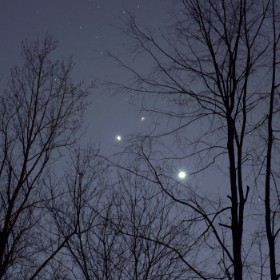
Subject: Jupiter and Venus in conjunction
Date: 2012-03-10, 7:19 pm (58 min after sunset)
Location: WV
Equipment: Modified Nikon D90, 18-105 mm lens at 58 mm
Exposure: f/5.6, 15 sec, ISO 200
Conditions: Clouds 0%, Transparency 2/5, Seeing 4/5, Lim mag 6.0,
RH 60%, 29°F
Notes:
The orbital inclination of Venus is 3.39° above the ecliptic while
Jupiter's is only 1.31°. When this picture was taken (Saturday),
Jupiter had not yet caught up with Venus. Venus was also slightly north
of the ecliptic (declination 14°50′)
and Jupiter was south of it (declination 13°31′)
(from ephemeris.com )
North is to the right.
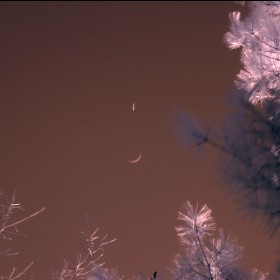
Subject: Moon on a plane
Date: 2012-03-26, 6:19 pm
Location: WV
Equipment: Modified Nikon D90, 18-105 mm lens at 105 mm, infrared filter
Exposure: f/36, 1/13 sec, ISO 200
Conditions: Clouds 0%, Transparency 3/5, Seeing 4/5,
RH 70%, 45°F
Notes: Infrared photo of airplane just before it transited the Moon.
Venus is partly visible behind the pine tree branch at right.
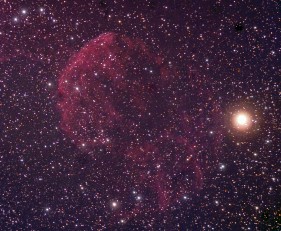
Subject: IC 443 (Jellyfish Nebula in Gemini)
Date: 2012-01-28
Location: WV
Equipment: WO FLT-110, 0.8x reducer/flattener, f/5.6,Modified Nikon D90, ISO 1600
Conditions: Clouds 0%, Transparency 4/5, Seeing 0 to 1/5, Limiting mag 5.9,
Humidity 65%, Temperature 32°F.
Exposure: ISO 1600, total exposure 62 min
Processing: DSS, Imal
Notes: A supernova remnant with extensive fine structure. Photographed under very
windy conditions. It was necessary to interrupt the photography of this object
several times to retrieve various objects blown away by the wind.
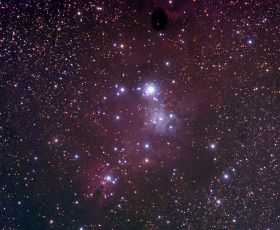
Subject: NGC 2264 (Christmas Tree Cluster + Cone Nebula + Snowflake Nebula)
Date: 2011-12-25
Location: WV
Equipment: WO FLT-110, 0.8x reducer/flattener, f/5.6,Modified Nikon D90, ISO 1600
Conditions: Clouds 0%, Transparency 3/5, Seeing 2/5, Limiting mag 6.2,
Humidity 85%, Temperature 27°F.
Exposure: ISO 1600, total exposure 45 min
Processing: DSS, Imal
Notes:
NGC 2264 in Monoceros includes the Cone Nebula (red cone at bottom) and the
Christmas Tree cluster just above it. The crinkly red area above and to the
right of the white Snowflake Nebula is called the Foxfur Nebula.
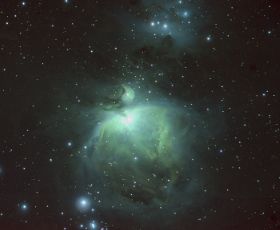
Subject: Near-Infrared / Visible Composite Image of Orion Nebula (M42)
Date: 2012-11-18
Location: WV
Equipment: WO FLT-110, 0.8x reducer/flattener, f/5.6,Modified Nikon D90, ISO 1600
Conditions: Clouds 0%, Transparency 3/5, Seeing 2/5, Limiting mag 6.2,
Humidity 85%, Temperature 27°F, UV Index 0 (low).
Exposure: ISO 1600, total exposure 20 min (Baader IR-pass) + 30 min (visible)
Processing: DSS, Imal
Notes:
This false-color image of the Orion Nebula was made by combining visible and
near-infrared images. Red = near-infrared filter (1000-680 nm), green = red
channel from a modified DSLR, and blue = green+blue channels from a DSLR.
It shows a little more detail than a visible-only picture (see below). The
upper portion (the Running Man Nebula) appears blue because it emits
a relatively small amount of infrared light.
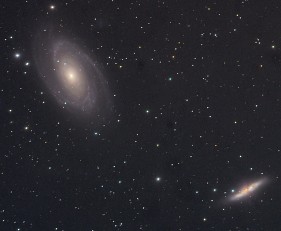
Subject: Messier 81 and 82 galaxies in Ursa Major
Date: 2012-01-29 (12-3am)
Location: WV
Equipment: WO FLT-110, 0.8x reducer/flattener, f/5.6,Modified Nikon D90, ISO 1600
Conditions: Clouds 0%, Transparency 4/5, Seeing 1/5, Limiting mag 5.9,
Humidity 65%, Temperature 31°F.
Exposure: ISO 1600, total exposure 162 min
Processing: DSS, Imal
Notes: These two galaxies are gravitationally linked. The center of M82 (right)
is surrounded by red nebulosity. A CCD camera with high sensitivity in the infrared
is needed to reveal it. M82 is the brightest object in the sky at infrared wavelengths.
It's an excellent test of a camera's sensitivity to infrared light. Even though the
DSLR camera used here was modified for IR, it's still not quite good enough.
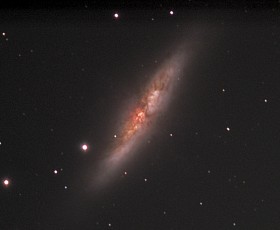
Subject: Closer view of Messier 82 galaxy in Ursa Major
Date: 2012-02-18
Location: WV
Equipment: C8HD, f/10, 2x modified Nikon D90, CGEM, no guiding
Exposure: ISO 1600, total exposure 85 min
Conditions: Clouds 0%, Transparency 2/5, Seeing 2/5, Limiting mag 6.0,
Humidity 85%, Temperature 28°F.
Processing: DSS, Imal
Notes: A more detailed view of M82. This telescope provides 3.15×
as much magnification as the 110-mm scope that took the picture at left.
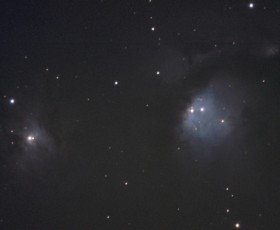
Subject: Messier 78 (NGC 2068, right) and NGC 2071 (left) in Orion
Date: 2012-02-26
Location: WV
Equipment: C8HD, f/10, 2x modified Nikon D90, CGEM, no guiding
Exposure: ISO 1600, total exposure 31 min
Conditions: Clouds 0%, Transparency 4/5, Seeing 3/5, Limiting mag 6.0,
Humidity 60%, Temperature 30°F.
Processing: DSS, Imal
Notes: M78 is a reflection nebula, caused by large clouds of interstellar
dust. This one was only visible for a half hour before going behind the
trees.
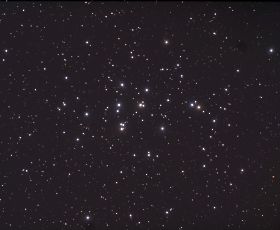
Subject: Beehive Cluster
Date: 2011-12-18
Location: WV
Equipment: WO FLT-110, 0.8x reducer/flattener, f/5.6,Modified Nikon D90, ISO 1600
Conditions: Clouds 0%, Transparency 2/5, Seeing 2/5, Limiting mag 6.2,
Humidity 85%, Temperature 30°F, UV Index 0 (low).
Exposure: ISO 1600, total exposure 130 min
Processing: DSS, Imal
Notes:
The Beehive Cluster (M44) in Cancer is also known as Praesepe. It's 577 light
years away, and is easily visible with the naked eye, making it a good target even
when the seeing is poor. The background in this image has been enhanced to show a
number of small galaxies. These galaxies make the Beehive a fascinating target.
A long exposure and good observing conditions are needed to make them visible.
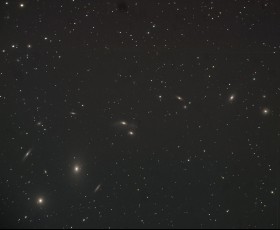
Subject: Markarian's Chain - a portion of the huge galaxy cluster in Coma Berenices
and Virgo
Date: 2012-01-29 (3-5am)
Location: WV
Equipment: WO FLT-110, 0.8x reducer/flattener, f/5.6,Modified Nikon D90, ISO 1600
Conditions: Clouds 0%, Transparency 4/5, Seeing 2/5, Limiting mag 6.1,
Humidity 65%, Temperature 30°F.
Exposure: ISO 1600, total exposure 62 min
Processing: DSS, Imal
Notes: This region contains hundreds of galaxies, including Markarian's Chain and
the famous Sombrero galaxy. About 40 galaxies are visible on this image, not including
numerous small ones that are only visible on the original unresampled image.
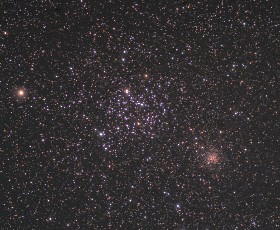
Subject: Messier 35 (M35) and NGC 2158 clusters in Gemini
Date: 2012-01-28
Location: WV
Equipment: WO FLT-110, 0.8x reducer/flattener, f/5.6,Modified Nikon D90, ISO 1600
Conditions: Clouds 0%, Transparency 4/5, Seeing 1/5, Limiting mag 5.9,
Humidity 65%, Temperature 31°F.
Exposure: ISO 1600, total exposure 25 min
Processing: DSS, Imal
Notes:
The smaller NGC 2158 star cluster appears pink or salmon-colored, because this
nebula is about one billion years old. M35 is only 150 million years old, and its
younger stars are still bluish.
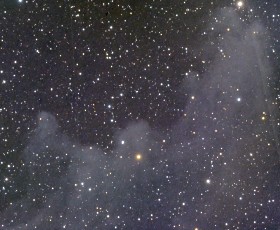
Subject: The Witchhead Nebula (IC 2118) in Eridanus
Date: 2011-12-03 and 2011-12-18
Location: WV
Equipment: WO FLT-110, 0.8x reducer/flattener, f/5.6, modified Nikon D90, CGEM, no guiding
Exposure: ISO 1600, total exposure 187 min
Processing: DSS, Imal
Conditions: Humidity 90%, Transparency 4/5, Seeing 3/5, Temperature 26°F
Notes: The Witchhead Nebula, located 900 light years away, is a giant cloud of dust
illuminated by Rigel, the glare from which is visible on the upper left. The nebula is
quite faint and difficult to photograph. It's impossible to know if you're really
pointing at the object until you combine many exposures the next day, when you discover
you should have taken many more. The satellite trails (right) are not, strictly speaking,
part of it. Click here for animated image of the
geosynchronous satellites in motion.

Subject: Moon lightning
Date: 2011-12-08
Location: WV
Equipment: Modified Nikon D90, 18-105 mm zoom lens, ISO 1600
Conditions: Clouds 30%, Transparency 1/5, Seeing 3/5, Limiting mag 4.0,
Humidity 70%, Temperature 28°F, Full moon, snow on ground
Notes: Moon lightning is not a real phenomenon, but an artifact that occurs when you move
the camera away with the shutter open while photographing the Moon. The appearance
resembles a single, powerful bolt of lightning. On the other hand, there's this
theory: The Moon, the theory goes, is very narcissistic,
and in retaliation for having its close-up ruined, the Moon strikes out at the camera
with a blast of Moon lightning. This one knocked the camera on its side and narrowly
missed the photographer.

Subject: Crab Nebula (M1)
Date: 2011-11-05
Location: WV
Equipment: C8HD, f/10, modified Nikon D90, CGEM, no guiding
Exposure: ISO 1600, total exposure 122 min
Conditions: Humidity 55%, Transparency 4/5, Seeing 3/5, Temperature 28°F
Notes: The Crab is a remnant of a supernova that exploded in the year 1054.
It is tough to get a good image of this little nebula in a small telescope.
On this image, I tried out the Richardson-Lucy deconvolution algorithm in
Pixinsight. The image was also cropped, sharpened, contrast-enhanced, and
run over with a car a few times in an attempt to sharpen it up.
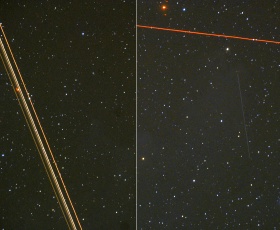
Subject: Airplane and satellite trails in Witch Head Nebula
Date: 2011-12-18
Location: WV
Equipment: Mod. D90, 18-105 mm zoom lens, ISO 1600
Conditions: Clouds 0%, Transparency 2/5, Seeing 2/5, Lim mag 6.2,
RH 85%, 30°F
Exposure: ISO 1600, 2 min
Notes:
The white tail lights of large passenger planes produce a distinctive four- or
five-line pattern, while the navigation lights create a pair of red and green
colored lines. Planes also have center beacons producing very short, intense red or
white flashes once per second that are easily confused with red stars, and white strobes
on the wingtips that are not always visible. Satellites (vertical line on right) are
fainter, but are easily seen with binoculars. Their brightness changes with their angle
to the sun. There are many more satellites than airplanes visible at any given time. Oh,
and the Witch Head Nebula (IC 2118, faint white cloudy area) is also in there somewhere.
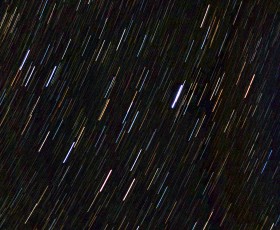
Subject: Star trails
Date: 2011-10-25
Conditions: Humidity 60%, Temperature 45°F, Limiting mag 6.2, Seeing 3/5, Transparency 3/5,
Clouds 10%
Equipment: Modified D90, 60 mm lens
Exposure: ISO=Lo1, 10 min
Location: WV
Notes: Star trails are longest at the equator. There's an art to making good star trail
images. If you expose too long, the trails appear to be complete circles, and the background
sky glow becomes objectionable. The sky also needs to be as dark as possible.
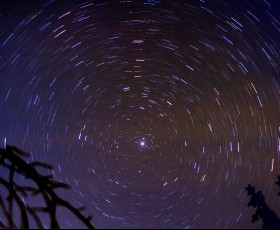
Subject: Star trails
Date: 2011-10-25
Location: WV
Equipment: Modified Nikon D90, 60 mm lens, ISO Lo1, 20min
Conditions: Transparency 3/5, Seeing 3/5, Clouds 10%, 45°F
Notes: Facing north. Note that the brightest star, Polaris, is not exactly at the pole.
Two small planes crossed the field of view. The top white and bottom red strobes are
visible.
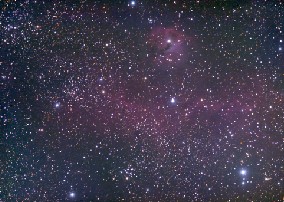
Subject: IC 2177 in Canis Major
Date: 2011-12-03
Location: WV
Equipment: WO FLT-110, 0.8x reducer/flattener, f/5.6, modified Nikon D90, CGEM, no guiding
Exposure: ISO 1600, total exposure 60 min
Processing: DSS, Imal
Conditions: Humidity 90%, Transparency 4/5, Seeing 3/5, Temperature 26°F
Notes: Sometimes called the Seagull Nebula. The "smiling head" part is also known as
NGC 2327 and is a reflection/emission nebula, which makes it bright and easy to find.
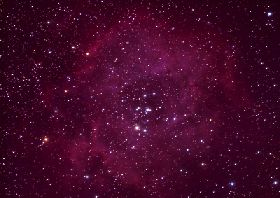
Subject: The Rosette Nebula
Date: 2011-11-25
Location: WV
Equipment: WO FLT-110, 0.8x reducer/flattener, f/5.6, modified Nikon D90, CGEM, no guiding
Exposure: ISO 1600, total exposure 47 min
Processing: DSS, Imal
Conditions: Humidity 90%, Transparency 3/5, Seeing 3/5, Temperature 30°F
Notes: The Rosette Nebula is associated with a star cluster known as NGC 2244.
These young bluish stars give the nebula a slight purplish tint. The Rosette
Nebula has been called the most beautiful object in the sky. It is also unusual
in that it also emits X-rays.

Subject: Heart Nebula
Date: 2011-11-01
Location: WV
Equipment: WO FLT-110, 0.8x reducer/flattener, f/5.6, modified Nikon D90, CGEM, no guiding
Exposure: ISO 1600, 77x60 sec, DSS
Conditions: Humidity 60%, Transparency 4/5, Seeing 4/5, Temperature 35°F
Notes: The ♥ Nebula between Perseus and Cassiopeia, also known as IC 1805, is
quite big, almost 2×2°--it barely fits in the frame here. It takes up almost
16 times as much of the sky as the Moon, yet most people have never seen it because
it emits most of its light at 656 nanometers, a wavelength the human eye can barely
detect. The Heart Nebula is a favorite of cardiologists, who often comment on the
prominent ventricular septal defect (center left) and the massively infarcted right
atrium (lower right).
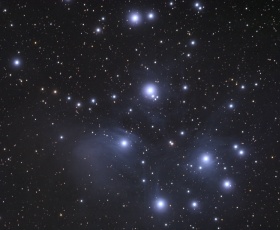
Subject: Pleiades Cluster (M45)
Date: 2011-10-08
Location: WV
Equipment: WO FLT-110, 0.8x reducer/flattener, f/5.6, modified Nikon D90, CGEM, no guiding
Exposure: ISO 1600, 61x60 sec, DSS
Notes: This cluster can be easily seen with the naked eye, but there are also
faint clouds of dust in the path which appear blue from reflected light. The
challenge for the photographer is to make these clouds visible without turning
the stars into blue giants.
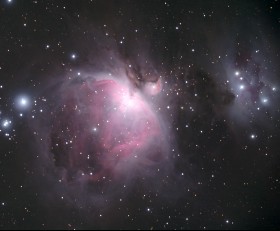
Subject: Orion Nebula (M42)
Date: 2011-10-08
Location: WV
Equipment: WO FLT-110, 0.8x reducer/flattener, f/5.6, modified Nikon D90, CGEM, no guiding
Exposure: ISO 1600, 94x60 sec + 14x10 sec
Processing: DSS, Imal 3.7.1
Notes: This photo was taken on the first clear night in my area in nearly a
month. After the moon finally set, the magnificent Orion Nebula became visible.
Unfortunately, by then it was six in the morning and I was too tired to fully appreciate
it. It is also the most challenging nebula to process, because of its extreme ranges
of brightness. On the left, you can also see several satellite trails. These
satellites seem to travel in packs as they go in polar orbits around the North Pole,
as if they're creating a Tholian web.
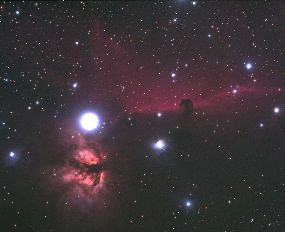
Subject: Horsehead Nebula in Orion
Date: 2011-10-23
Location: WV
Equipment: WO FLT-110, 0.8x reducer/flattener, f/5.6, modified Nikon D90, CGEM, no guiding
Exposure: ISO 1600, 52x60 sec, DSS
Conditions: Humidity 95%, Transparency 3/5, Seeing 4/5, Temperature 36°F
Notes: The famous Horsehead Nebula is a star-forming region shrouded in a dark
cloud of dust, which blocks the red light from the hydrogen emission nebula behind it.
This photo was taken from 4:00 and 5:30 am. The enormous star at the center left is
Alnitak, one of the three stars in Orion's belt. It's nearly impossible to see this
nebula with the naked eye, but it shows up easily in a modified digital camera.
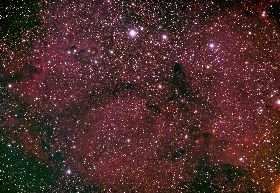
Subject: Elephant Trunk Nebula in Cepheus
Date: 2011-11-01
Location: WV
Equipment: WO FLT-110, 0.8x reducer/flattener, f/5.6, modified Nikon D90, CGEM, no guiding
Exposure: ISO 1600, 79x60 sec, DSS
Conditions: Humidity 60%, Transparency 4/5, Seeing 4/5, Temperature 35°F
Notes: The Elephant Trunk Nebula is a small part of the enormous nebula IC 1396
in Cepheus. The "trunk" portion (upper center left) is actually a dark nebula
consisting of a cloud of dust that obscures a star-forming region. Herschel's
Garnet Star is visible in the lower right.
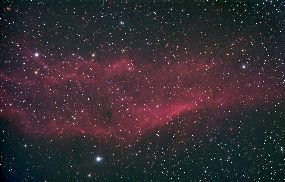
Subject: California Nebula in Perseus
Date: 2011-10-23
Location: WV
Equipment: WO FLT-110, 0.8x reducer/flattener, f/5.6, modified Nikon D90, CGEM, no guiding
Exposure: ISO 1600, 49x60 sec, DSS
Conditions: Humidity 95%, Transparency 3/5, Seeing 4/5, Temperature 38°F
Notes: Because of the humidity, water was condensing over the equipment, my maps, and
me the entire time this picture was being taken, ruining almost half the exposures. At
least I didn't have to take a shower afterwards.
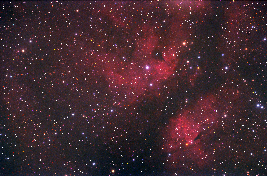
Subject: IC 1318 Nebula in Cygnus
Date: 2011-08-22
Location: WV
Equipment: WO FLT-110, 0.8x reducer/flattener, f/5.6, modified Nikon D90, CGEM, no guiding
Exposure: ISO 1600, 18x60 sec, DSS
Notes: This is a portion of IC.1318, an Hα emission nebula near Sadr
in the constellation of Cygnus. The top portion is known as IC 1318d and the bottom
portion is IC 1318e. Sadr is just off the upper center right. This region of space is
crawling with nebulas, which are basically enormous clouds of dirt and gas hundreds of
light years across.
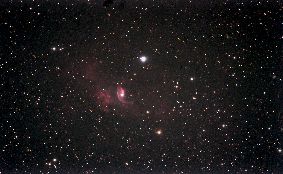
Subject: Bubble Nebula NGC-7635 in Cassiopeia
Date: 2011-08-26
Location: WV
Equipment: C8HD, f/10, modified Nikon D90, CGEM, no guiding
Exposure: ISO 1600, 51x60 sec, DSS
Notes: The Bubble Nebula is a cloud of dust and gas six light-years in diameter
being pushed away from the star near the left edge of the bubble by its intense
solar wind. The configuration and orientation of other stars create the illusion
that they are being reflected from the surface of a giant bubble in space.
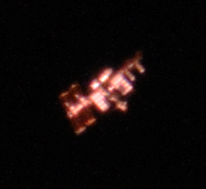
Subject: International Space Station
Date: 2011-08-31
Location: WV
Equipment: C8HD, f/10, modified Nikon D90, custom-made mount, no guiding
Exposure: ISO 1600, 1/1000 sec
Notes: Multiple views of the International Space Station as it passed overhead.
Maximum elevation was 70 degrees. It was only visible for one minute; after the
last frame, it went behind the clouds. The space station appears to be rotating
due to different angles of each frame with respect to the ground.
If you go cross-eyed, you can see it as a 3-D image.
This object is 109 meters long--big enough to photograph it from
374 kilometers away. That's a bit smaller than Noah's Ark (238 vs 300 cubits).
It's only 30 trillionths of a light year away, but it moves so fast that it's
tough to track it without getting motion blur.
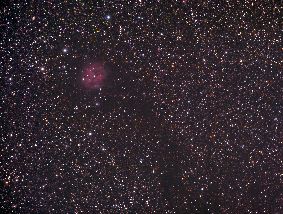
Subject: Cocoon Nebula
Date: 2011-09-18
Location: WV
Equipment: WO FLT-110, 0.8x reducer/flattener, f/5.6, modified Nikon D90, CGEM, no guiding
Exposure: ISO 1600, 117x30 sec, DSS
Notes: Cocoon Nebula (IC 5146), a reflection/emission nebula in Cygnus. This nebula has a
"tail" caused by the dark nebula B168.
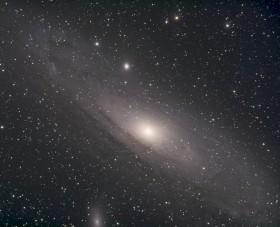
Subject: M31, the Andromeda Galaxy
Date: 2011-11-25
Location: WV
Equipment: WO FLT-110, 0.8x reducer/flattener, f/5.6, modified Nikon D90, CGEM, no guiding
Exposure: ISO 1600, total exposure 82 min
Conditions: Humidity 95%, Transparency 3/5, Seeing 3/5, Temperature 31°F
Notes: The galaxy of Andromeda contains vast quantities of dirt, some of which can
be seen in this photograph. It's possible to photograph Andromeda with only a camera
and a zoom lens (see next image at right), but the result is not as sharp.
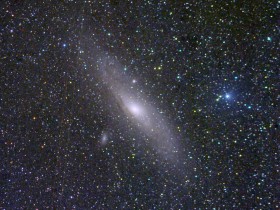
Subject: Andromeda Galaxy, photographed without a telescope
Date: 2011-12-01
Location: WV
Equipment: Nikkor 70-300 zoom lens, set at 200 mm, f/4.5, modified D90, CGEM,
no guiding
Exposure: ISO 1600, total exposure 140 min
Notes: Many objects, including Andromeda, the Pleiades Cluster and the Orion Nebula,
are big enough to be photographed without a telescope, using just a plain camera and
a cheap zoom lens. With a modified camera, you can
also photograph the Horsehead Nebula. An inexpensive tracking drive is adequate. Your
images might not be as sharp,
but you can get a much wider
field of view, which can be spectacular. This Andromeda image, while perhaps not all
that spectacular, shows a typical result. Compare with the image at left taken
with a 4.3-inch refractor.

Subject: NGC 7000, the North America Nebula
Date: 2011-08-23
Location: WV
Equipment: WO FLT-110, 0.8x reducer/flattener, f/5.6, modified Nikon D90, CGEM, no
guiding
Exposure: ISO 1600, 103x60 sec, DSS
Notes: The North America Nebula covers a region of the sky four times the size of the
Moon. In a CCD camera, the nebula appears red because of the red H-alpha (Hα)
glow at 656.281 nanometers. This wavelength is emitted after a proton combines with
an electron to form neutral hydrogen, in a process known as radiative recombination.
It's very difficult to see with the naked eye because the human eye can barely detect
this wavelength.
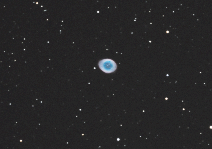
Subject: Ring Nebula in Lyra
Date: 2011-07-02
Location: WV
Equipment: Nikon D90 + C8 EdgeHD (f/10)
Exposure: 31x30 sec (unguided), total 15.5 min, ISO 1600.
Notes: One of the smaller nebulas, but it's so bright that photos in a small
scope often become over-exposed.
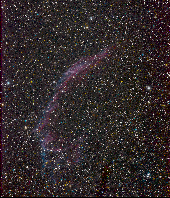
Subject: NGC 6992 - Eastern Veil Nebula
Date: 2011-06-26
Location: WV
Equipment: WO FLT-110, 0.8x reducer/flattener, f/5.6, Nikon D90, CGEM, no guiding
Exposure: ISO 1600, 95x30 sec, DSS
Notes: Imaging was cut short early (at 4:30) when the moon rose, turning
the sky blue. The Veil Nebula is almost impossible to see from this location
even with a telescope. The question is, can we really say we saw something if
it takes three hours of computer processing to make it visible?
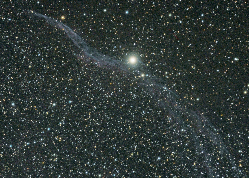
Subject: Right half of Veil Nebula
Date: 2011-07-02
Location: WV
Equipment: WO FLT-110, 0.8x reducer/flattener, f/5.6, Nikon D90, CGEM, no guiding
Exposure: ISO 1600, 88x30 sec, DSS (total exposure 44 min)
Notes: This is the dimmer "middle" and "right half" (Western) portions of the
Veil Nebula in Cygnus. At my location, it is impossible to see it in a telescope
except with a camera and long time exposures. The Veil Nebula pushes the
limits of what an unmodified D90 can do.
This nebula is so big that it can be photographed with an ordinary zoom lens.
However, a good telescope keeps the star sizes smaller, making it easier
to see the nebula.
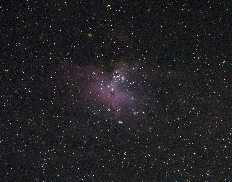
Subject: Messier 16 - Eagle Nebula
Date: 2011-06-29
Location: WV
Equipment: WO FLT-110, 0.8x reducer/flattener, f/5.6, Nikon D90, CGEM, no guiding
Exposure: ISO 1600, 14x30 sec, DSS
Notes: Eagle nebula in Serpens. The so-called Pillars
of Creation are visible. The nebula is low on the horizon, and was only
visible for a short time in a space between the trees--proof that the
most important tool in astrophotography is your chainsaw.
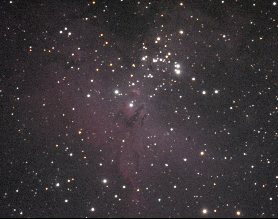
Subject: Messier 16 - Eagle Nebula
Date: 2011-07-02
Location: WV
Equipment: Nikon D90 + C8 EdgeHD (f/10)
Exposure: 105x30 sec (unguided), total 52 min, ISO 1600.
A closer view of the Eagle nebula using a telescope with greater magnification.
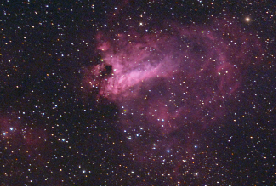
Subject: Swan Nebula
Date: 2011-08-23
Location: WV
Equipment: WO FLT-110, 0.8x reducer/flattener, f/5.6, modified Nikon D90, CGEM, no guiding
Exposure: 11x60 sec (unguided), total 11 min, ISO 1600, stacked in DSS.

Subject: Fireflies
Date: 2011-06-06
Location: WV
Equipment: Nikon D90
Exposure: 30 sec, 3x3 binning, no guiding
Notes: It was too cloudy and humid to get any pictures of the stars, but
there were so many fireflies they illuminated the trees and cast a shadow
in this 30 second time exposure. When they are above a certain density,
fireflies synchronize their flashes with each other. The typical pattern
is 4-5 one-second-long flashes, followed by 10-15 seconds of dark.
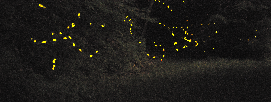
Subject: Fireflies
Date: 2011-06-06
Location: WV
Equipment: Nikon D90
Exposure: 30 sec, 3x3 binning, ISO 1600
Notes: The biochemical reactions used by
fireflies are fascinating and have been used in many commercial
products for medicine and science. There were more little yellow
dots in my back yard than in the sky ... and no guiding was needed.
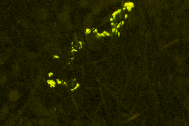
Subject: Fireflies in the rain
Date: 2011-06-21
Location: WV
Equipment: Nikon D90
Exposure: 30 sec, 2x2 binning
Notes: When the wind picks up, the flashing rate of fireflies increases
to as high as five flashes per second. They can be seen taking cover in
the grass where they often flash continuously for several minutes at a
time. Fireflies are somewhat fragile, and mowing the lawn greatly reduces
their number. This is a 30 second time exposure image of a single firefly
crawling around in the grass. Note the striking resemblance to the Veil
Nebula (above).
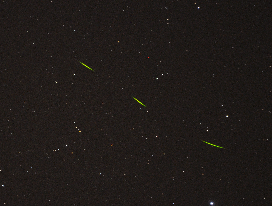
Subject: Firefly in Ursa Major
Date: 2011-05-30
Location: WV
Equipment: Nikon D90 + C8 EdgeHD + focal reducer (f/7)
Exposure: 30 sec (unguided), ISO 1600.
Notes: A firefly flew in front of the telescope while I was taking this
wide-field image of Ursa Major. They appear white to the eye, but are
actually a yellow-green color.
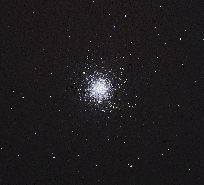
Subject: Messier 13
Date: 2011-05-30
Location: WV
Equipment: Nikon D90 + C8 EdgeHD + focal reducer (f/7)
Exposure: 12 x 30 sec (unguided), total 6 min, ISO 1600.
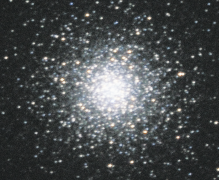
Subject: M3 (Messier 3)
Date: 2011-05-09
Location: WV
Equipment: Nikon D90 + C8 EdgeHD
Exposure: 32 x 30 sec, ISO 1600
Notes: Stacked using DSS.
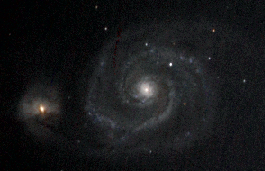
Subject: M51 (Whirlpool galaxy)
Date: 2011-05-11
Location: WV
Equipment: Nikon D90 + C8 EdgeHD, f/10
Exposure: 116 x 30 sec (unguided), total 58 min, ISO 1600.
Notes: It was very hard to see this galaxy in the finder because the
half-moon was near the zenith, making the sky background very light.
But that made it easy to avoid tripping over the scope and ripping
the cables out of the camera. Not that I ever did that.
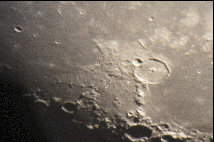
Subject: Half Moon
Date: 2011-04-14
Location: WV
Equipment: Nikon D90 + C8 EdgeHD
Exposure: 1/10"
Notes: Photo taken with lens on camera. Camera was 1 inch in front
of a 6.7mm eyepiece. There was a lot of turbulence--parts of the moon
were moving in all directions, like a reflection in the water.
The large crater at center-right is Gassendi. Compare this single
frame with the stacked AVI of the same region at right.
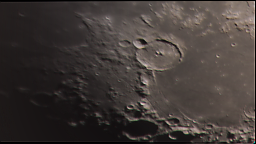
Subject: Half Moon
Date: 2011-04-14
Location: WV
Equipment: Nikon D90 + C8 EdgeHD
Exposure: AVI, 1248 frames
Notes: Photo taken with lens on camera. Camera was 1 inch in front
of a 6.7mm eyepiece. This image was created by stacking from a movie
created by a D90 DSLR. Stacking greatly reduces image noise, allowing
you to sharpen the image. Even though the image at left
was taken with higher resolution (4288×2848 vs. 1280×720
for the AVI), the stacked image is much sharper. (Parameters: max
movement 30, 11 align points, 1123 frames stacked with Registax)
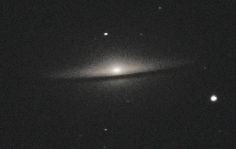
Subject: Sombrero galaxy
Date: 2011-05-09
Location: WV
Equipment: Nikon D90 + C8 EdgeHD, f/10
Exposure: 38 x 30 sec, ISO 1600
Notes: Stacked using DSS.
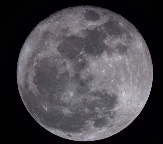
Subject: Supermoon
Date: 2011-03-20
Location: WV
Equipment: Nikon D90 + C8 EdgeHD
Exposure: 1/30"
Notes: Supermoon is the term for when the moon is unusually close
to the Earth. Even though it's only a few percent closer, that is
enough to prevent the camera from capturing the entire moon in a single
frame. This photo was created by compositing two half images together.
The color saturation has been artificially increased to show the subtle
red coloration of some of the craters.
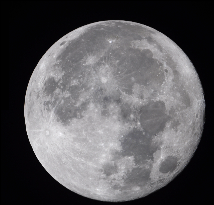
Subject: Supermoon
Date: 2011-03-20
Location: WV
Equipment: Nikon D90 + C8 EdgeHD
Exposure: 1/30"
Notes: Camera was at prime focus.
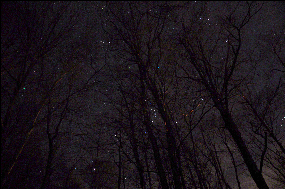
Subject: Stars and M42 behind the trees
Date: 2011-01-04
Location: WV
Equipment: Nikon D90
Exposure: 20 sec
Notes: In the summer, trees on the south end of my property block
the view up to about 75 degrees. In the winter, the magnificent Orion
Nebula can be seen behind the bare trees (purple fuzzy area near the
cluster of blue stars in center of picture).
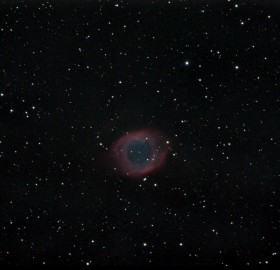
Subject: Helix Nebula in Aquarius
Date: 2013-11-03
Location: WV
Equipment: WO FLT-110, 0.8x reducer/flattener, f/5.6, modified Nikon D90, CGEM, SG4
Exposure: ISO 400, 35 min total exposure
Notes: The Helix Nebula (NGC 7293), sometimes called the Eye of God, is about half the
size of the Moon, yet most people have never seen it because it is too faint to be
visible to the naked eye. It is so low on the horizon that it's only visible for 40
minutes at my location.
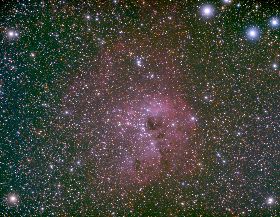
Subject: IC 410 - The Tadpole Nebula
Date: 2011-11-25
Location: WV
Equipment: WO FLT-110, 0.8x reducer/flattener, f/5.6, modified Nikon D90, CGEM, no guiding
Exposure: ISO 1600, total exposure 94 min
Processing: DSS, Imal
Conditions: Humidity 95%, Transparency 3/5, Seeing 3/5, Temperature 31°F
Notes: The Tadpole Nebula (IC 410) in Auriga, like the Rosette Nebula (above) is
superimposed on a star cluster which provides the radiation that excites the
hydrogen atoms to produce their characteristic red HII glow. The name comes from
the two pink tadpole-shaped objects left of the center dark area.
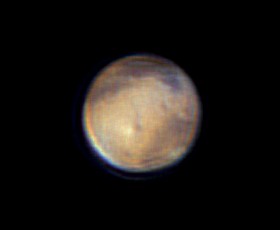
Subject: Mars
Date: 2012-03-10
Location: WV
Equipment: C8 EdgeHD (f/10) + modified Nikon D90
Conditions: Clouds 0%, Transparency 2/5, Seeing 4/5, Lim mag 6.0,
RH 60%, 29°F
Exposure: ISO 1600, AVI, 5760 frames stacked
Processing: Registax, Max local contrast filter in Imal
Notes: No one will ever confuse this with an image from the Hubble telescope,
but this is probably typical of what you can get with an 8-inch telescope
from the ground. Like Jupiter, Mars rotates too rapidly to combine images
taken more than a few minutes apart. The white area near the center is not a
specular reflection, but a cloud. It has been known for many years that Mars
has clouds as well as a polar icecap.
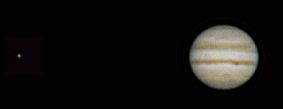
Subject: Jupiter
Date: 2011-09-09
Location: WV
Equipment: Modified Nikon D90 + C8 EdgeHD, CGEM, 6.7mm eyepiece,
afocal, no lens
Exposure: AVI, 2880 frames
Notes: One of Jupiter's moons is also visible on the left.
Jupiter rotates on its axis so rapidly that even photos taken
five minutes apart cannot be combined.
Stacked with Registax and sharpened (Registax parameters: max
movement 30, 31 align points, 2880 of 7200 frames aligned. Imal
parameters: convolution filtering 15x15, 4%; Laplacian wavelet
filtering to remove stacking artifacts). Even though extensive
processing improves the image, a better result can be obtained
with a webcam. For really good images of planets, you need a
high-end CCD webcam like a DMK or a Lumenera Skynyx.
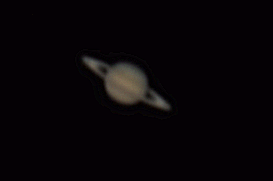
Subject: Saturn
Date: 2011-04-14
Location: WV
Equipment: Nikon D90 + C8 EdgeHD
Exposure: AVI, 515 frames
Notes: It is notoriously hard to capture a clear image of Saturn with
a DSLR. It looks sharp in the eyepiece, probably because the eye integrates
detail over time. In this photo, the camera lens was removed and the camera
was placed about an inch from a Meade 6.7mm UWA eyepiece.
Stacked with Registax and sharpened.
